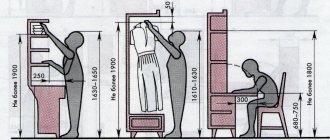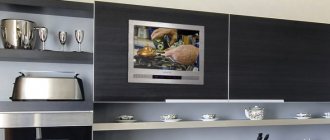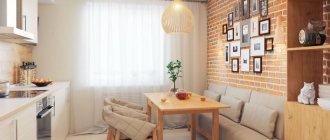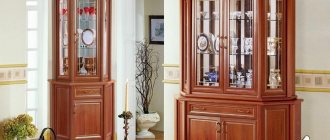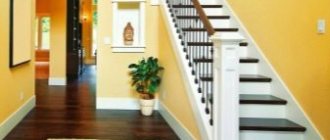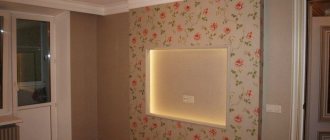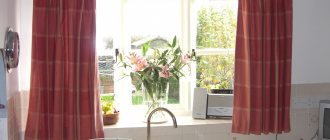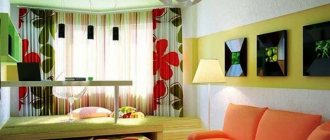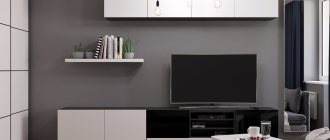The TV in the kitchen has long been an integral attribute, which serves as an excellent background and makes the cooking process more distracting. Whether you are specifically buying a TV for the kitchen or moving it from another room, it doesn’t matter, the main thing is to find a suitable place for it. Sometimes fitting a new piece of equipment into a ready-made and equipped kitchen can be problematic. It seems that there is simply no room for a TV anymore, or it doesn’t suit the style, etc. To avoid any difficulties, we have selected 5 tips and successful photo examples of kitchen design with a TV.
Is it possible to put a TV in the kitchen?
This question is asked by many, especially if the kitchen space is quite small, which is often found in old Soviet-built multi-storey buildings and modern studio apartments, where the size of kitchens may not exceed 6 m2. Of course, placing a TV in the kitchen of such an apartment is quite problematic, because you need to make sure that the TV does not take up unnecessary space, that moisture and grease do not get on the screen, as well as heat from the hob or oven. But even in such a situation there is always a way out, and more than one:
1. You can place a small kitchen TV on the dining table or on the wall above it using a VESA mount. The AVEL company offers 2 options for truly compact TVs - a model with a 9-inch screen AVS090CM and a portable TV model with a 14-inch screen AVS133CM. You can not only watch such TVs in the kitchen, but also take them with you outdoors, to the country house or to the yard to watch your favorite TV channel in the fresh air. Thanks to the built-in digital tuner and battery, you can take out the TV only when necessary, and put it away on the shelf the rest of the time. Such a TV will not take up much space in the kitchen and, most importantly, will not interfere at all even when placed on the table.
2. The second option for placing a TV in the kitchen is to integrate a compact TV with a screen diagonal of up to 24 inches directly into the kitchen unit. The compact built-in TV models AVS220W and AVS240WS are best suited for this. These models were designed specifically for small spaces and can be easily installed in place of the fronts of standard 600 mm wide kitchen cabinets. Behind the TV, just like behind a regular cabinet door, you can store absolutely any thing, be it dishes or food, that is, such a TV does not require any additional space at all.
How to properly attach a TV to the wall?
If, in your layout, the location of the TV involves mounting it on a wall, you must first check the technical feasibility of performing this operation. Remember: you cannot hang a heavy monitor on a plasterboard wall. It will not withstand more than 30-35 kg and risks simply collapsing.
Remember: you cannot hang a heavy monitor on a plasterboard wall. It will not withstand more than 30-35 kg and risks simply collapsing.
The monitor can be mounted on a wall made of bricks or blocks using brackets. In this case, make sure in advance that there is no wiring in the places where the dowels are supposed to be located.
The brackets come in both rigid and adjustable types. We recommend choosing the mobile option in any case. Who knows, what if you need to change the angle or slightly rotate the screen in one direction or another.
What size TV should I choose for the kitchen?
When choosing the size of a TV for the kitchen, you should be guided by the following rule: the diagonal size of the TV (in centimeters), multiplied by three, should be equal to the distance to the TV from the viewer. Of course, this rule is not mandatory, because modern LCD TVs are quite safe for the eyes. But if you are going to watch kitchen TV for a long time, then it is better to adhere to this rule. Some examples:
- if you place the TV in the kitchen at a distance of 1.5 meters from the viewing point, then the diagonal of the screen should be no more than 20 inches (2.54 cm * 20 inches * 3 = 152.4 cm);
- If you place the TV in the kitchen at a distance of 3 meters from the intended viewing location, then the diagonal of the screen should not exceed 40 inches.
Is it necessary to organize separate local lighting above the TV?
I answer: no, it is not necessary, since glare from the lamp will interfere with the perception of images on the screen. However, there is no need to watch TV in complete darkness: the contrast of a bright screen and complete darkness of the surrounding space not only reduces viewing comfort, but can also negatively affect vision.
The best option is dim background lighting. For example, a chandelier with a dimmer set to minimum brightness. Or several spots, the beam of light from which can be directed into a wall or corner. Also suitable are built-in miniature LED lamps that produce dim, limited light. Even local illumination of paintings or mirrors can successfully play the role of background lighting when watching TV.
Proper placement and good lighting affect the picture quality on your TV. Of course, if we are not talking about such ultra-modern devices as curved OLED TVs
, which will provide you with an excellent image in any lighting and position in front of the screen.
But what if your TV is not equipped with innovative features and technologies? What is the correct way, and most importantly where, to place the TV?
1)
We do not recommend placing the TV near a window.
The light from the window combined with the light from the screen is very tiring for the eyes; 2)
Do not place the TV in front of a window.
Direct sunlight falling from a window onto the screen interferes with viewing; 3)
The height of the TV depends on the way it is viewed (lying/sitting), as well as on the purpose of the room in which it is planned to be installed.
Often the TV is hung at a height of 120 cm from the floor to the center of the TV. A universal rule: hang the TV so that its top third is at eye level when watching; 4)
No need to cover the TV with napkins.
It is not recommended to place interior or household items on it, especially those that contain liquid; 5)
Install the TV away from radiators and damp places;
6)
Most TVs “love” twilight.
If you have good daylight, you should consider blackout curtains on your windows. 7)
The distance from the TV should be equal to 3-4 of its diagonals. In other words, a 40-inch TV will be viewed correctly from 3 meters away.
At what distance should you watch TV?
In order for your eyes not to get tired and your vision to not shrink over time, you need to know at what distance to watch TV
.
The distance directly depends on the diagonal of the TV. As described in paragraph 7 - “The distance from the TV should be equal to 3-4 of its diagonals.
In other words, a 40-inch TV will be viewed correctly from 3 meters,” below we have given a small table on the distance from the TV depending on its diagonal.
Translation from CNET.com
Where the sun doesn't shine. Seriously.
No matter what size or type of TV you have, it's worth thinking about where best to place it. Maybe the place where he always stood is not ideal for a television screen. Perhaps moving the TV with a little rearrangement of furniture will allow you to achieve better image quality or make you decide to buy a model with a larger screen.
Obviously, if you have a huge screen TV, then your placement options are quite limited. But perhaps they will expand by rearranging the furniture?
Before placing a 22" LCD display in the corner of the room under the ceiling or an 84" 4K screen in the middle of the room, consider the following tips.
Pay attention to…
Screen height.
While there are no specific height guidelines for your TV, ideally you won't want to mount it too high. In order to always look at the screen as if you were sitting in the first row of a cinema. This is not very convenient, especially in the case of long sessions, not to mention possible restrictions on vertical viewing angles. Generally speaking, it is desirable for the center of the TV screen to be approximately at eye level, or even slightly lower. This is worth considering in case of wall mounting, and not just when using the display on a tabletop stand.
Distance from the screen.
It's unlikely that you're going to sit too close to the TV. Most people are positioned about three meters away from the screen, where it's impossible to tell the difference between 1080p and 720p TVs for most screen sizes. By being closer to the screen, you get two main benefits. The field of view is widened so that what's on the screen is more immersive and you can see more detail in the image, especially with higher display resolutions. If you can't or don't want to sit close to the screen, you may want to consider buying a new TV with a larger screen.
Check the placement.
Room lighting and reflections of light sources are the main culprits in deteriorating TV image quality. Although almost every modern TV has an anti-glare screen coating, you shouldn’t expect miracles from it, its possibilities are not limitless. Of course, you can simply turn off the lights or draw the curtains tighter, but sometimes this is not so easy or even impossible.
If you choose to wall mount your TV, still keep in mind all the features mentioned above. Additionally, if you have an LCD display, make sure the wall mount you use will allow you to rotate or adjust the position of the screen. With few exceptions, LCD display quality deteriorates as you move away from the center of the screen. The ability to rotate the screen so that it's directly in front of your eyes will make a major improvement in picture quality (compared to a similar TV that isn't pointed at you). It is worth noting that today's TVs are quite lightweight, which makes it easy to securely mount even fairly large displays on the wall.
Let's take into account the style.
Modern TV models are often distinguished by their original tabletop designs, but, depending on the design, they are not always rotating. Whatever style you like, most stands are almost the same size in height, a few centimeters higher or lower is ideal - it doesn't really matter, but a large screen on a high stand definitely doesn't look good.
Ensure safety.
It turns out that televisions falling and injuring a child are far from a rare occurrence. Make sure your TV is securely mounted or positioned to prevent it from falling, especially if you have children or pets.
Do not install the TV too high. When you're standing, the TV screen may seem really low, but it will look great when you sit in front of it since most of the time you won't be standing while watching TV.
Do not install the TV above the fireplace for the reason stated above.
Do not install the TV outdoors (in the garden, ...). There are TVs made specifically for outdoor use. If you don't want to spend money on a TV designed for outdoor use, just know that any indoor TV left outside probably won't last as long (even if it's covered). It's best to bring it indoors when you're not using it.
Don't sit too far from the screen. However, in order to compensate for the remote distance, you can buy a model with a larger diagonal.
Do not install the TV in such a way that you have to look at the screen in an awkward position. If you have to sit with your head constantly turned throughout the entire movie, it will simply strain your neck muscles. Although turning your head a little may not seem like a big deal, maintaining this position for several hours can literally cause pain.
Where to place the TV in the kitchen and is it possible to install the TV above the hood or stove?
When designing a kitchen space, designers favor grouping kitchen appliances in one area or part of the kitchen unit in order to free up space in the rest of the kitchen, creating a more functional area. Installing the TV together with the rest of the equipment will help harmoniously fit it into the overall design. AVEL offers several solutions that will suit the most demanding customers. Built-in kitchen TVs have the width of standard kitchen cabinets, and the front front panel is made of tempered glass in three colors (black, white, mirror) to perfectly match any built-in appliances.
Do you want to install a TV above the hood? This is possible, because AVEL TVs are designed for such solutions and are not afraid of heat, vibration, moisture or greasy drops. The front panel of the TV can be washed with any non-abrasive means, the glass reliably protects the matrix. The standard width for 22" and 24" TVs is 60 cm, which corresponds to the most common hood size. The width of the AVS320K / AVS320KS TV is 90 cm, which is also the standard for built-in hoods and cabinets above them.
If you want to install a TV above the stove, then this issue should be taken care of even before renovating the kitchen, since not every device can cope with such a non-standard solution. Just like installing a TV behind the kitchen sink, this option requires a custom TV.
In this case, a regular TV will not only heat up, but its plastic parts may melt from the heat. The best solution would be to integrate the TV into the kitchen apron, for example, the AVS240SM model. However, it is worth remembering that the TV installed above the stove will have to be washed very often, since even the most powerful hood will not protect it from drops of fat, which will inevitably fall on the tempered glass that protects the matrix.
In our opinion, the most successful options for placing a TV in the kitchen are:
- placement of the TV in a “column” or in a single block with other built-in kitchen appliances (oven, microwave, coffee maker);
- installing a TV in upper cabinets in any convenient place, even above the hood.
Installing a TV in the kitchen in this way will not only allow family and guests to watch TV while standing or gathered in different areas of the room, but will also make your home more modern and aesthetically pleasing. Previously, this option was only available when making a special custom-made TV, but now everyone can afford a built-in TV.
The most important:
Regardless of how and where you are going to place the TV in the kitchen, you should also think about how to connect all the necessary interfaces - from power and antenna cable to various set-top boxes or a satellite receiver. That is why it is so important to think through all the details before ordering a kitchen set and before renovating the entire kitchen space.
Where to hide wires and cables?
There are three most common options:
- Cable channel. You can cover it with wallpaper or paint it the same color as the walls to make it less noticeable.
- Grooves in the floor, wall, ceiling. Suitable only if you are sure that you will not change the location of the TV until the new repair.
- Special furniture for a TV with a well-thought-out system for the arrangement and fixation of wires.
If your apartment is currently under renovation
Design and properly prepare the location of the TV and the corresponding terminals for it in advance. What you will definitely need: 2 regular sockets behind the monitor, 1 for the Internet and 1 television. In them you will connect the plasma monitor itself, a tuner and/or a Wi-Fi adapter. All these outputs can be safely hidden behind the plasma monitor itself, placing the sockets at a distance of 8–10 cm from the top or bottom edge of the monitor (whichever is more convenient in your situation).
If there is a TV stand under the TV, on which other media equipment will presumably be placed, the sockets behind it will also not hurt you. At a height of 25-30 cm from the floor, place a block with 4-5 sockets: even if you don’t need them now, technology doesn’t stand still - it’s better to spend a little money now and save yourself from unnecessary problems with wires, sockets and carriers tomorrow.
If the repair has already been done
All wires can be hidden in a cable box and carefully brought to the TV. Later, this box can be designed to match the style of the wall on which it is located - in order to disguise it as much as possible.
If the TV is located opposite the window and you decide to take advice about curtains on an electric curtain rod, plan another outlet under the ceiling in the place where such a curtain will hang (curtain specialists and an electrician will tell you more about this).
What is a kitchen touchpad on Android system?
A unique new product on the world market is a 22-inch Android touch panel built into kitchen furniture on the Android operating system with Wi-Fi and Bluetooth functions, as well as a built-in camera. This touch panel uses a protective front surface made of tempered glass, which is easy to clean with special detergents (non-abrasive) and is not afraid of greasy stains.
This model is designed specifically for lovers of smart technology. With its help, you will always stay up to date with the latest news, exchange rates and traffic conditions thanks to widgets displayed on the screen. The touch panel for the kitchen will also help you control all smart home systems without using your phone. You can quickly turn on a smart kettle or robot vacuum cleaner, as well as any other gadgets controlled via Wi-Fi or Bluetooth. Thanks to the built-in camera and microphone, you can communicate with loved ones, friends or colleagues without stopping cooking or eating. In addition, any applications available on the Google Play Market will now be in your kitchen.
Today, this is the only model of a large tablet computer that is built into standard kitchen cabinets using lifting mechanisms and does not take up extra space. A touch panel for the kitchen is a real breakthrough in built-in appliances!
Biofireplace and animals. Will they take root or not?
“What if I have two cats and a dog at home, but I dream of a bio-fireplace?” You can purchase it and install it at home using our tips:
- 1. Do not allow pets to approach the fire. Try to scare them off with something, for example loud sounds or water. Over time, they will develop an instinct that will not allow them to be near a flame.
- 2. All animals love warmth, so they will probably try to lie down closer to the fireplace. Keep them safe by placing your pets' favorite bed at a distance of at least 40 cm. This way, they will be comfortable and you won't have to worry about your furry friends.
- 3. If you have parrots, do not let them fly around the room while the bio-fireplace is burning.
- 4.The best option is to install a built-in bio-fireplace with glass, which will be protective and fire-resistant. So, you definitely won’t let your pets “singe their whiskers.”
Check out our bio fireplaces
Tabletop bio-fireplaces Floor-standing bio-fireplaces Built-in bio-fireplaces Fuel blocks Wall-mounted bio-fireplaces
